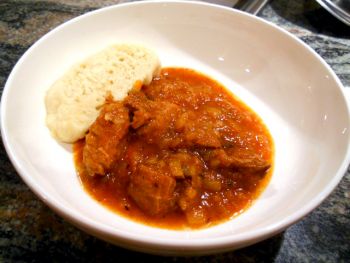
Jan 23 Guláš S Knedlíkem
- canola oil
- 3 pounds beef (suitable for stewing), cut into 1/2" to 1" pieces
- 2 large onions, diced
- 5 roma tomatoes, diced
- 2 to 3 tablespoons sweet paprika
- water
- 2 green bell peppers, diced
- 9 small russet potatoes, peeled and diced
- 1 to 2 teaspoons ground cumin
- 1 to 2 teaspoons dried oregano
- 2 cloves garlic, crushed
- black pepper to taste
- salt to taste
Guláš is the Czech spelling of goulash, a dish with many variations throughout central and eastern Europe, but a dish generally based on the theme of meat seasoned with paprika. I first had guláš when I was in Prague this past summer. I fell in love with it and the spongy Czech dumplings often served alongside that were unlike anything I'd ever had before. I remember an evening wandering through Prague with my friends. We were lost in the rain after a short-cut had gone awry, and I was about as content as a wet cat with my glasses so spotted with rain I could hardly see. It was a warm plate of guláš and dumplings at the end of that evening that made everything better. Later in the same trip we were greeted by another delicious pot of guláš made by my friend's mother when we arrived in Pilsen. So, it's a dish closely associated with fond memories of that trip, which is part of why I love recipes as a kind of memento from past travels.
This is a batch of guláš I whipped up while visiting family in Colorado for Christmas. I think making some of the foods you encountered is a fun way to share a part of your travels with others. There were about ten of us, so it needed to be a large batch to serve everyone. There wasn't much more than a couple small bowlfuls left by the time we were finished.
I began by salting and browning the meat in the oil in small batches. Once the last batch was browned, I added the onion and all of the meat back into to the pot and cooked it until the onion was soft and turning translucent. I shut the heat off temporarily to avoid burning the paprika, then stirred the paprika in, letting it fry just briefly in the oil. I added the tomatoes to the pot and turned the heat back on. After the tomatoes had cooked just a few minutes, I added enough water to cover the meat, plus a little extra for the ingredients yet to come.
I let just those ingredients already in the pot simmer gently about a half hour or so by themselves. That gave me time to prepare the other ingredients and start assembling what I needed for the dumplings. I then added the bell peppers and potatoes. All told, I let the guláš simmer about 2 to 3 hours.
During the last half hour I added the cumin, oregano, black pepper, and the garlic I had run through a press. There are a couple things to note on the spices. First, oregano is not the correct herb. It should be marjoram, but there was none in my mother's cupboard so I substituted the oregano. There is also some debate about what one of the other spices should be. In Czech, kmín means both cumin and caraway. Recipes in Czech call for kmín, but just which one they mean is the question for cooks in the US. You will find recipes that call for caraway seed. My gut said cumin is just a better match for the flavors in the dish, so that's what I stuck with. My Czech friend also said it should be the less anise-like of the two, which certainly seemed like cumin to me, but others are free to make their own call.
At the very end of cooking, I seasoned it with salt to taste, and served it up with warm dumplings.
The Dumplings (Knedlíky)
- 1 tablespoon sugar
- 3 teaspoons yeast
- 1 teaspoon salt
- 1 cup milk
- bread flour
These dumplings were created somewhat ad-hoc with the help of my Slovak friend, so the flour measurement isn't exact, but they're not hard to make. In the bowl of an electric mixer, I mixed together the sugar, yeast, salt, and milk that I had heated to just about blood temperature. I then weighed out 500g (or about 1 pound) of bread flour. With the mixer on low, I slowly added in enough of the flour for a dough to form. As soon as the dough was thick enough, I switched to the dough hook attachment. I continued adding in enough flour until the dough pulled away from the sides of the bowl and formed a ball. This did not take all of the flour, there was quite a little left over. I then continued to knead the dough for about 3 minutes.
After kneading the dough, I removed the bowl from the mixer, covered it, and let it rise about an hour. At the end of the hour, I punched the dough down and formed it into two logs of about equal size. The logs went into a steamer for about 30 minutes, just until they were slightly firm and would spring back when touched.
Cutting the dumplings into slices is best achieved with a piece of cotton twine or even unwaxed (and unflavored) dental floss. Lacking either of those, I used a length of clean nylon fishing line which I wrapped around the large dumpling and then pulled perfectly tight, cutting through the dough.
We served up the guláš in bowls with a dumpling or two on the side of each. It was a very delicious item to bring back from traveling. As the Czechs say: dobrou chut'!
